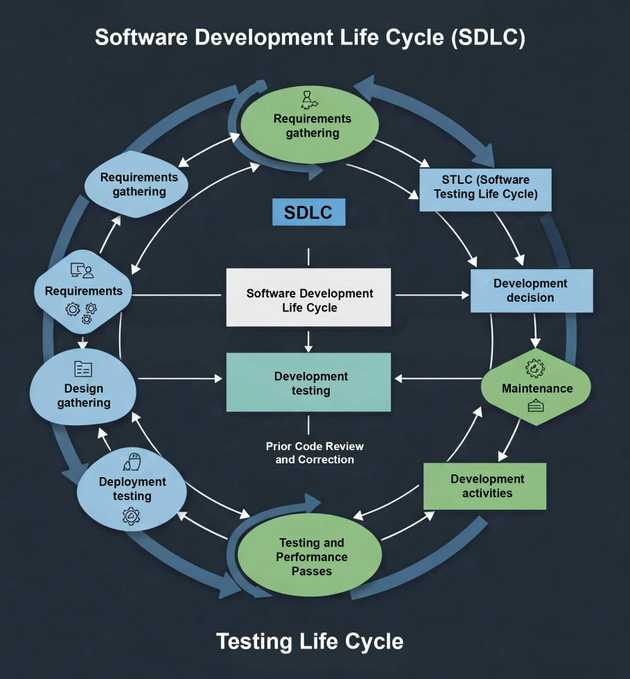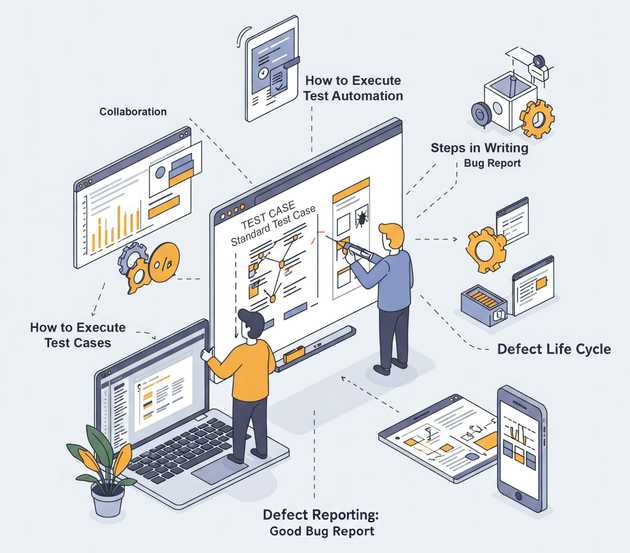Software quality is crucial for the success of any application. Whether you’re launching a mobile app, a web platform, or an enterprise solution, manual testing plays a vital role in ensuring everything works as expected. Unlike automated testing, which relies on scripts, manual testing requires human intuition, creativity, and analytical skills to uncover hidden issues.
If you’re looking to build a strong foundation in manual testing, this guide will walk you through everything—from testing fundamentals to test execution, defect reporting, and release documentation.
1. Introduction to Manual Testing
What is Manual Testing?
Manual testing is the process of manually executing test cases to identify defects in software without using automation tools. It ensures that the application behaves as intended before release.
Why is Manual Testing Important?
- Identifies usability issues that automation may overlook
- Ensures functionality works across different scenarios
- Plays a critical role in exploratory and ad-hoc testing
- Helps in early-stage validation before automation scripts are developed
Manual vs. Automation Testing
| Feature | Manual Testing | Automation Testing |
|---|---|---|
| Execution Speed | Slower | Faster |
| Human Intuition | Yes | No |
| Best for | Exploratory, UI, Usability | Regression, Load, Performance |
| Initial Cost | Low | High |
2. Software Development Life Cycle (SDLC) & Testing Life Cycle (STLC)
Understanding SDLC
The Software Development Life Cycle (SDLC) is a structured process that defines the steps to develop and maintain software. Testing is a key part of this cycle.
STLC: The Tester’s Roadmap
The Software Testing Life Cycle (STLC) outlines how testing fits into software development. It consists of:
- Requirement Analysis — Understanding what needs to be tested
- Test Planning — Creating a strategy, defining scope, and resources
- Test Case Development — Writing clear, reusable test cases
- Test Execution — Running test cases and logging defects
- Defect Reporting & Tracking — Documenting issues for developers
- Test Closure — Summarizing test results and lessons learned
3. Types of Testing in Manual Testing
Functional Testing
- Unit Testing — Testing individual components
- Integration Testing — Ensuring modules work together
- System Testing — Validating the entire system’s functionality
- User Acceptance Testing (UAT) — Checking if the software meets business requirements
Non-Functional Testing
- Performance Testing — Evaluating speed and responsiveness
- Security Testing — Identifying vulnerabilities
- Usability Testing — Assessing ease of use
Other Essential Testing Types
- Regression Testing — Ensuring recent changes didn’t break existing functionality
- Smoke Testing — Verifying basic functionality before detailed testing
- Sanity Testing — Checking bug fixes before full regression
4. Test Planning and Test Case Design
What is a Test Plan?
A test plan is a document that outlines the scope, objectives, approach, and schedule for testing. It ensures testing is systematic and covers all critical aspects.
Test Case Design Techniques
- Equivalence Partitioning — Dividing data into valid and invalid groups
- Boundary Value Analysis — Testing edge values of inputs
- Decision Table Testing — Handling multiple input combinations
- State Transition Testing — Checking how the system behaves with state changes
5. Test Execution & Defect Reporting
How to Execute Test Cases
- Follow test steps as per the documented test cases
- Mark each test case as Pass, Fail, or Blocked
- Capture screenshots and logs for reference
Defect Reporting: Writing a Good Bug Report
A well-written bug report includes:
- Title: Clear and concise description of the issue
- Steps to Reproduce: Exact steps to replicate the issue
- Expected vs Actual Result: What should happen vs. what actually happens
- Severity & Priority: Impact of the defect and urgency of the fix
- Attachments: Screenshots, logs, or videos for better clarity
Defect Life Cycle
- New — Defect identified
- Open — Assigned to a developer
- In Progress — Being worked on
- Fixed — Developer resolves the issue
- Retest — Tester verifies the fix
- Closed/Reopened — Defect closed if resolved, reopened if not
6. Test Management Tools
JIRA for Test Case & Bug Tracking
JIRA is one of the most popular tools for managing test cases, tracking bugs, and reporting progress in Agile projects.
Test Case Documentation in TestRail or Excel
- TestRail is a structured tool for maintaining test cases
- Excel is a simpler alternative for smaller teams and projects
7. Agile Testing and QA’s Role in Agile Teams
How Testing Works in Agile
- Testing happens continuously instead of at the end of the project
- Shorter development cycles mean frequent releases
- Testers work closely with developers in sprints
Scrum vs. Kanban for Testing
- Scrum: Testing follows sprints with defined goals
- Kanban: Testing happens in a continuous flow without fixed iterations
8. Status Reporting and Release Notes
How to Send Test Status Updates
Daily/Weekly Test Reports should include:
- Test execution progress
- Pass/Fail counts
- Open defects and blockers
- Next steps
Writing Effective Release Notes
A release note informs users about new features, bug fixes, and known issues. It should include:
- New Features: What’s been added
- Bug Fixes: Issues that were resolved
- Known Issues: Problems still present
Best Practices for Clear Reporting
- Keep it concise and structured
- Highlight critical issues and major changes
- Use bullet points for better readability
Final Thoughts
Manual testing remains a critical skill for software testers, as it ensures a deep understanding of application behavior beyond automation scripts. Whether you’re starting out or refining your skills, mastering test case design, execution, defect tracking, and reporting will set you apart in the field.
Looking to enhance your testing skills? Dive deeper into real-world testing scenarios and explore tools like JIRA, TestRail, and exploratory testing techniques. Stay updated, keep testing, and ensure software quality like a pro!
Frequently Asked Questions (FAQs)
- Is manual testing still in demand?
Yes! Many companies rely on manual testers for usability testing, exploratory testing, and validating complex workflows. - Can I become a tester without coding skills?
Absolutely! Manual testing focuses on analysis, observation, and documentation rather than coding. - What is the best tool for manual testing?
JIRA for bug tracking, TestRail for test management, and Excel for simple test documentation.
Share this blog on:




